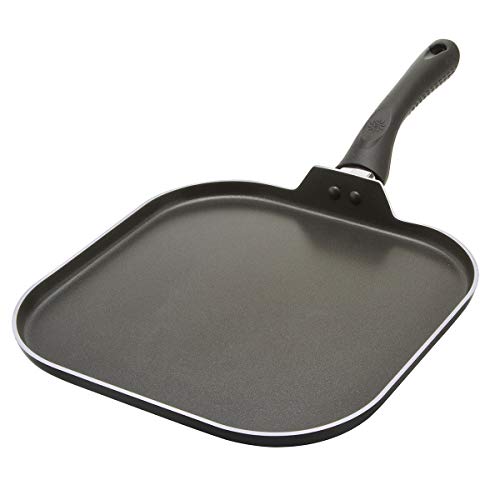Looking for a cookware upgrade? A square skillet might just be what you need. With its unique shape and versatile features, a square skillet can offer a twist on the traditional cooking experience. This buying guide will help you select the ideal square skillet that suits your kitchen's needs and cooking style. From material and heat distribution to ease of cleaning, we'll cover all the factors to enhance your culinary creations and transform your meals and kitchen space.
Key Considerations When Shopping for a Square Skillet
You will need to keep the following factors in mind:
Material
There are quite a few options for construction materials when it comes to square skillets. Cast iron is the most favored and superior choice for a square grill or griddle pans. This is because of their impeccable ability to evenly and quickly distribute heat through the material, from the center to the edges. This material also retains heat longer and produces better results. These pans are heavier than all other kinds. Aluminum square skillets are another popular choice. This material does not retain stains or marks and is lighter than cast iron pans. They offer satisfactory heat distribution and are easier to handle. Another choice is copper as it is suitable for cooking an array of food. Copper square skillets also have anti-bacterial properties. You can also find square skillets made from stainless steel. This material has excellent heat conductivity and is durable as well. However, these pans are thin and might not do great if not coated with a non-stick layer.
Heat conduction and retention
Another important consideration is the ability of the pan to retain and spread heat. The skillet should be able to cook all the food laid on it evenly and thoroughly. And that is possible only when the skillet is distributing heat to every corner of the skillet. The skillet you’re considering buying should have good heat retention properties. This means that the pan should not drop in temperature quickly when you remove the heat source.
Size
Choosing the size is all about the frequency you’d be using it and for how many you’d be cooking for on average. However, it’s best to go for a large-sized square skillet for a good amount of space.
Ease of use
The skillet should be easy to use, handle, and clean. This includes considering the weight, kind of handles, lid design, and maintenance requirements. You can get a non-stick pan if you do not wish to spend time refreshing the seasoning on a cast-iron skillet. Similarly, go for a skillet with a long handle and a comfortable grip. The skillet should not be too heavy or too light.
Non-stick coat
If you’re getting a non-stick square skillet, make sure that it’s good quality and durable. It should have multiple layers of the non-stick coat. Be sure to get PFOA and toxins-free coating so that all the food you cook in the skillet is healthy.
How to Pick a Quality Square Skillet
Some essential qualities of a good skillet are:
Durable construction
Thin-gauge construction material will hold and spread heat unevenly. They’re prone to denting and warping as well. A good quality skillet is made from a heavy-gauge material are heavy, and is a good heat conductor.
Heatproof handling
Welded, riveted and screwed metal handles tend to get hold. A good skillet comes with protection from this heat with either plastic, silicone, or wooden handle ends. High-end skillets can also feature ovenproof, heatproof handles as well.
Heated sides
Pan sides should get as hot as the middle. Cooking items like oven roasts require heat from the sides and that’s only possible if the skillet can allow even heating.
Nonreactive coat
For acidic food like wine sauces, tomato, fruit fillings, etc. the skillet’s surface shouldn’t react. High-end skillets with enamel, and anodized aluminum do great with such foods.
Tips to Maintain a Square Skillet
Some general care and maintenance tips for skillets are:
- Carefully read through the instructions from the manufacturer that are specific to the material of the skillet.
- Never put the skillet under water while it is hot. Always wait for it to get completely cold.
- For cast-iron square skillets, make sure you don’t leave the skillet to dry in the air after cleaning.
- Use mild detergent to clean a skillet. Soak it in warm water for 10-15 minutes if there are stubborn stains or food residue.
- Do not wash the skillet after every use.
- Regularly season a cast iron pan to enhance its non-stickiness and flavor buildup.
- Do not cook citrusy food frequently on the skillet as it might damage the surface.
- When you’re charring any food item, make sure you let it sit on one side until it’s well-marked to avoid it from sticking to the pan.
Benefits of Square-Shaped Skillets
A few advantages of using a square pan for your food are:
- Square pans are wide and have extended corners, unlike round or circular skillets. They can accommodate large meals at one time without under or overcooking anything.
- This cookware shape offers about 25% more cooking area as compared to round pans and skillets.
- Square pans and skillets are ideal for braising and brewing meat as the corners are short-heightened making it a lot easier to spoon out the juices.
- They are handier than other round-shaped pans.
Conclusion
An important yet often overlooked factor that influences the flavor and texture of a cooked meal is the shape of the cookware it’s prepared in. Square skillets come in a variety of textures, materials, handling, and safety features. This guide suggests the best square skillets in 2023 to help you get one.




